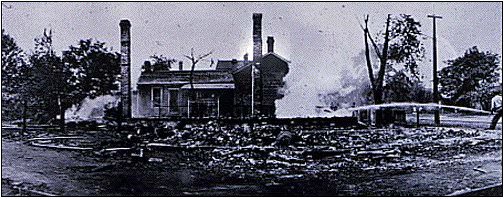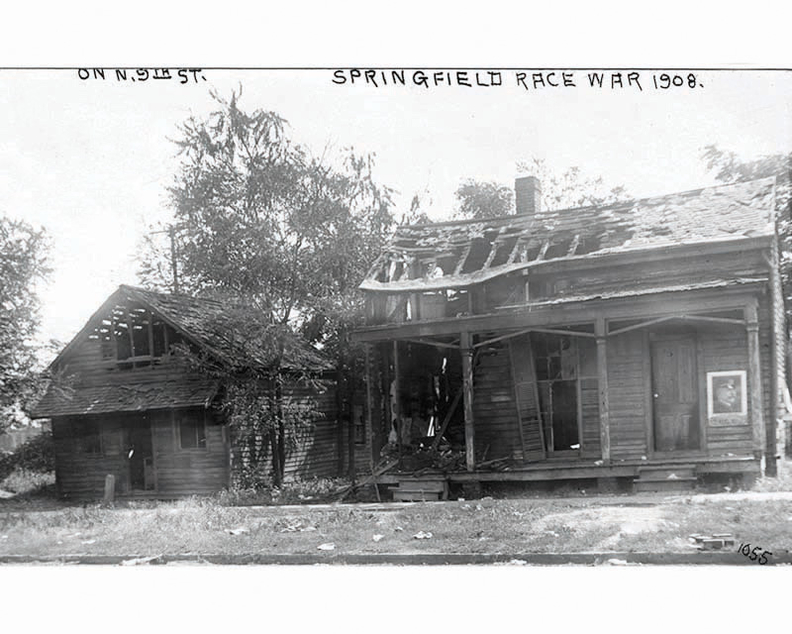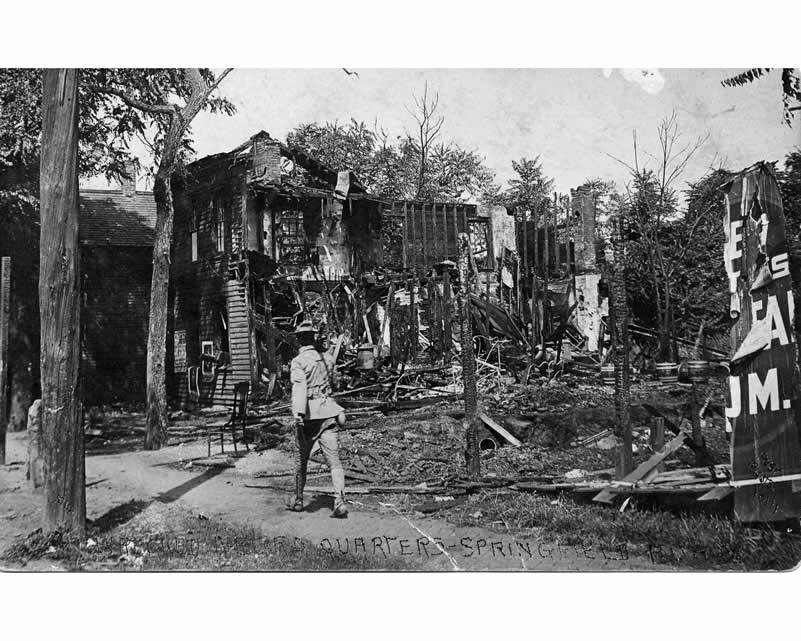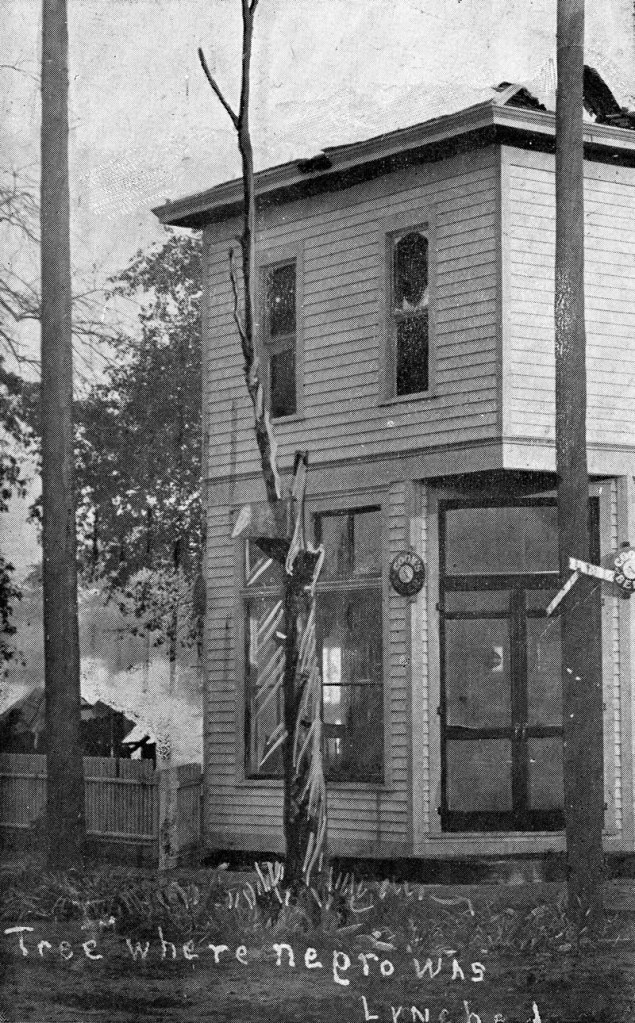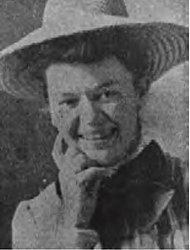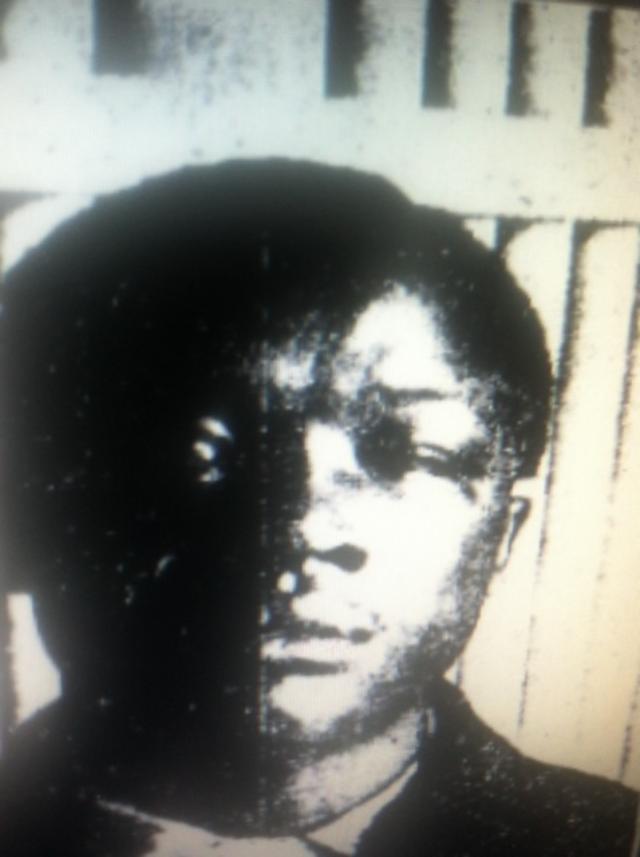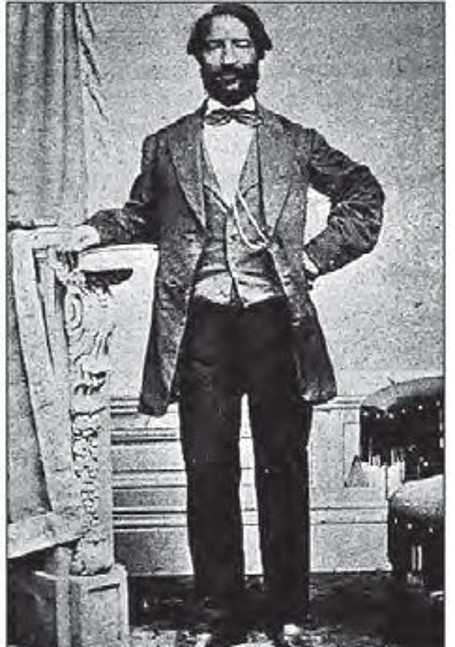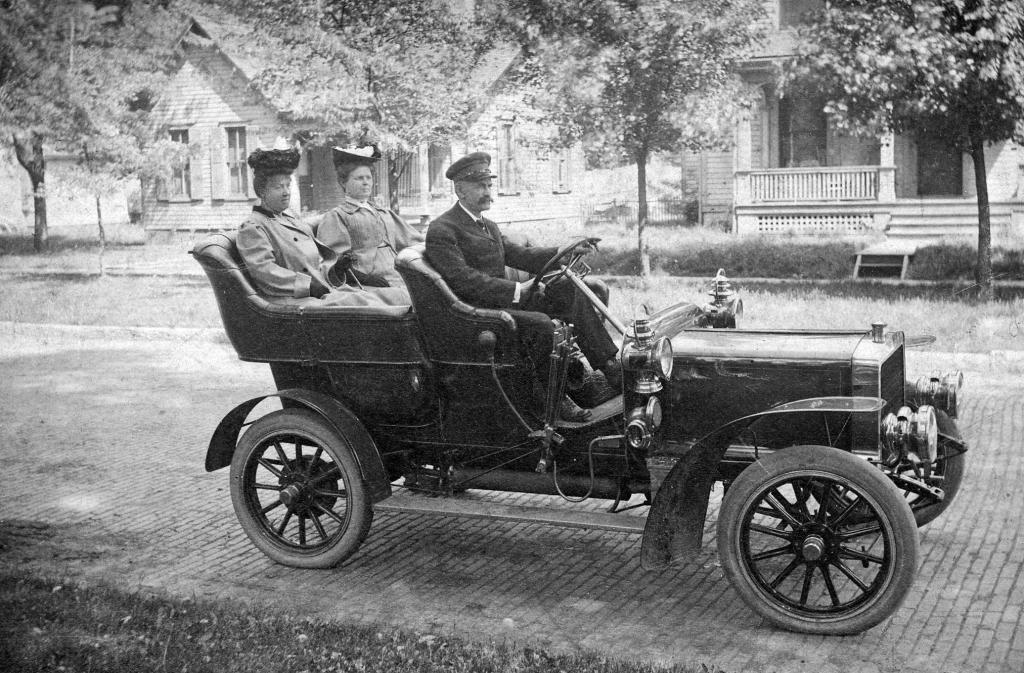
Acts of Intolerance, by Preston Jackson
The Springfield, Illinois 1908 Race Riot
Many African Americans fled the south to the north in hopes of alleviating some of the racial problems they suffered in the southern states of America. However, racism and segregation lurked in the north just as it did in the south, but at times it seemed to be a tolerant nuisance. However, in 1908 in Springfield, Illinois that tolerance ran out for African American’s. Lynchings were cruel and heinous acts of terror perpetrated by many White Americans to control the social, economic and political advancements in the lives African Americans.
“Lest we Forget,” reads the head stone of Scott Burton and William Donnigan, the murdered African American victims of the Springfield Race Riot of 1908. The Springfield Race Riot of 1908 was a tragic event that dehumanized the lives of African Americans and for many years it was hidden in the newspapers and in the memories of those that were there. However, in the last three decades the Springfield, Illinois Race Riot of 1908 has been explored and examined over and over, and there are many, many aspects to its horror. In 1995 the City of Springfield placed historical markers in the area were the race riots occurred. Then in 2009 sculptor Preston Jackson was commissioned by the City of Springfield Illinois, State of Illinois and the Springfield, Illinois NAACP to create two 14’ cast bronze columns depicting the events and aftermath of the Springfield Illinois Race Riot of 1908 called the “Acts of Intolerance.” There has also been new interest in the race riot since the Springfield Rail Improvement Project uncovered remains of homes that were involved in the tragic event. This newfound interest is crucial to understanding today’s discourse on racial inequality, police brutality, and social unrest. An examination of the truth, the details, the aftermath and actors from the perspectives of both Black and Whites in this real-life drama may help to reconcile race relations.
Audio Recording of Tour
What Happened?
On August 13th Mabel Hallam, declared that she had been raped and attacked at her home at 1145 North 5th Street, by an African American man. However, that was a lie! Mabel Hallam had been having an affair on her husband Earl Hallam, and the man she was seeing beat her during an altercation, he was white. Hallam describes her alleged assault as taking place at about 11:30pm, by a African American man that had entered her house through an unlocked kitchen door. This African American man allegedly climbed into bed with her and she supposedly thought it to be her husband Earl. She said that the man then touched her face and she then knew that it was not her husband.
The supposed African American man then choked her, pulled her from her bed, dragged her naked body from the house into the back yard where he assaulted her. After the alleged assault Mabel screamed for help and her mother-in-law came. A few hours later (August 14, 1908) the newspapers announced the alleged rape and attack of Mabel Hallam. The newspaper reports fueled the racial hostilities that existed in Springfield during that time. The very last sentence of the newspaper is a call for Whites to raise up against African American’s. The Illinois State Register said, “No, effort should be spared to find the black viper and force appropriate punishment.”
Early that morning the sheriff’s office decided to question a group of African American men working in Mabel Hallam’s neighborhood. The men were taken to Mabel Hallam’s home and paraded to see if she could identify her alleged assailant. She did not identify any of the men as the Black viper, and the men returned to their work site. One of the labors was a man named George Richardson. After returning to his work site Richardson promptly walked off the job in protest to the accusation. His actions may have made him a suspect in the alleged crime. Shortly thereafter he was arrested. Mabel Hallam was then summoned to the jail house with her husband Earl, so that she could identify Richardson as her supposed attacker. Mabel Hallam signed an affidavit that George Richardson was her assailant. Richardson was then formally charged with rape. As the news spread that a man had been arrested for the rape and attack of Mabel Hallam, groups of angry White men assembled at the jail. The mob were not assembled at the jail just for Richardson, but for an African American man named Joe James, who a month earlier was arrested for the murder of a White citizen named Clergy Ballard.
Marker 1: Sangamon County Jail House
The first marker is at 7th and Jefferson the site of the Sangamon County Jail.
George Richardson was formerly charged with the rape and attack of Mabel Hallam at 3:30pm. His bond was set at 3,000.00 dollars.
George Richardson and Joe James was under the care of Sheriff Charles Warner.
As the news spread that Richardson had been arrested for the rape and attack of Mabel Hallam, groups of angry white men assembled at the jail.The crowd grew into a violent mob, and they began to demand that Sheriff Warner and his men turn Richardson and James over to them, so that they could “force appropriate punishment upon them” as the newspaper had instructed them to do. As day turned to night, Warner worried about the safety of his prisoners as he knew that he had the legal responsibility to keep Richardson and James safe. A law passed in 1906 by the Illinois Legislature called for law enforcement to do all within their power to prevent any harm to prisoners under their care and custody.
Warner decided late that night as the mob became more violent and boisterous to remove the prisoners and take them to Bloomington, Illinois until their trial was to be held. Warner had the fire department create a distraction so that Richardson and James could be loaded into Harry Lopers car and taken to Sherman, Illinois to catch the train to Bloomington.
Sheriff Warner asked Loper to help because Loper was known to help during difficult times and circumstances. For instance, Mr. Loper helped the father-in-law of one the Meyers Brothers (a wealthy family that owned the largest retail store in town. It was the Macy’s of Springfield), by taken the doctor 30 miles to Athens’s to perform an emergency appendectomy.
Harry Loper was a wealthy merchant of Springfield. He owned an upscale restaurant and owned the first car dealership in Springfield. His car was the fastest in town at that time, it was a 1907 Dorris Touring car.
As Lopers car left the police station from the alley on Washington street, someone saw the prisoners with the authorities.
This unexpected act inflamed the mob! And they decided to go to Loper’s restaurant to confront him once he returned to town.
Marker 2: Lopers Restaurant
Marker 2 is at 5th and Monroe and is the site of Harry Loper’s restaurant, the Good Samaritan that helped the Sherriff remove the prisoners from the jail.
Loper’s restaurant was described as a very fine, elegant restaurant, much like the restaurant Maldener’s, which still exists today.
The rioters accursed Loper of sympathizing with African Americans and many Whites did not favor having friendly relationships with African American’s.
After confronting Loper about his actions and assaulting him with incredible insults the mob began to destroy Lopers restaurant and his car. The time is about 12:00 am August 15th.
One of the first casualties of the riot happened here. His name was Louis Johnston (quite often by mistake, his name appears as Louis Johnson). It is not clear if Johnston was a rioter or an innocent patron of Loper’s restaurant.
And the bullet that killed him may have come from Loper while he and his employee’s hid in the basement to protected themselves. Loper attested to the Grand Jury that he fired warning shots to stop the mob from breaking into the basement area. So one of those bullets may have hit Louis Johnston.
Loper and his staff escaped from a basement window.
The mop also looted his store. One rioter suspected as the main leader, named Kate Howard stole a large can of lard. Howard claimed that it was to be a souvenir.
Across the street Mayor Roy Reece hid in a shop from the mob after being struck with a bottle and/or brick when he tried to reason with the mob.
After looting and destroying Lopers restaurant the rioters went to the business area of town called The Levee around 7th & Washington.
Marker 3
In this area the mob wrecked and destroyed countless Black and Jewish businesses in the Levee area.
There were not just saloons and houses of ill-repute in the Levee/business area of town, as it was rumored to be; there were regular everyday businesses; barber shops, beauty shops, corner grocery stores, hardware stores, and much, much more. Many were flourishing economically and picking up political power as well.
Yet, race relations where tense as jobs were scarce and for African Americans doing well, economic jealousy existed.
The thought was: How dare a group of Black people be doing better than a White man.
The mob targeted a Jewish pawn shop called Fishman’s and stole guns, ammo, knives, axes, and other weapons.
From there the rioters headed to the northeast side of town where many African Americans lived, worked, and worshiped.
Marker 4: The Badlands
Many African American citizens lived on the northeast side and they knew of the unrest and fled their homes before things got worse. This area was called The Badlands by the media, and those not living in the area. This area would later become a housing project named John Hay Homes and then Madison Park Place.
Not all African American citizens living in the area were able or willing to leave their homes. As the rioters reached The Badlands, they immediately began to destroy property and beat murderously any African American person insight.
The blood thirsty rioters cried racist epithets and wreaked havoc on the lives of African Americans living on the northeast side Springfield (Illinois State Register Aug. 21, 1908:1). One rioter shouted, “Twenty-five dollars for a N—-r! This cry was aimed at Scott Burton. An African American business owner that was defending himself and family against savage rioters that where bent on “forcing appropriate punishment” on Burton or any other African American that crossed their path.
According to Scott Burton’s daughters that survived the horrific ordeal, this is what happened,
Scott Burton was pulled from his home then beaten further before he was hung from a dead tree near his home. Scott Burton was lynched at about 2.00am, August 15, 1908. After Burton’s death the evil mob shot up his lifeless body, to further dehumanize him as a man and other fiendishly cruel things were done to the body.
According to reports in the Illinois State Journal the rioters “gashed his body with knives, attempted to start a fire under his corpse, and nearly all his clothes were torn away,” exposing his genitals. The mob cut pieces of wood from the tree that Burton was hung from as souvenirs.
Shortly after Burton was lynched the militia arrived. The militia were able to stop further destruction of Burton’s corpse. The troops had been called in by Governor Charles Deneen to protect the city and especially its African American citizens and put an end to the riots; when Springfield city officials such as Mayor Roy Reece and law enforcement failed to take control of the situation. Yet, the troops failed in many ways to protect the life and property of African Americans. Many of the soldiers sympathized with the mentality of the mob.
Burton was killed and laid to rest on the same day of August 15th, 1908. He was interned at Oak Ridge Cemetery without his family or friends ever being able to give their final good-byes (ISJ Aug. 16,1908:3).
By 8:00 am the morning of the 15th Scott Burton had been murdered, countless men had been beaten, families displaced and over eighty homes and businesses had been destroyed by the mob.
Marker 5: Payne’s Hardware Store
After the morning murder of Scott Burton and the destruction of the Northeast side of town where many African American people lived, the mob was docile. However, around 7 pm the mob started up again. The mob broke into Payne’s Hardware store. They stole rope, ammo, and other weapons and headed to the Military Arsenal on 2nd and Adams street. where African American’s looking
Marker 6: The Illinois Military Armory
The mob attempted to take over the Illinois State Armory at 2nd and Adams were many African American people went to for shelter and safety from the blood thirsty mob. The African American citizens of Springfield had to run to the armory to hide with their families, carrying as much of their belongings as they could carry, while escaping. However, many African Americans left Springfield never to return.
After failed attempts to take over the arsenal to “force appropriate punishment” on African Americans taking shelter there, the mob headed Southwest to the home of William Donnegan across the street from where the Illinois State Museum is now.
Marker 7: William Donnigan Home
William Donnegan was a wealthy retired 84 year old African American cobbler, real estate investor, and former Underground Railroad Conductor, who was married to a Caucasian woman. The Donnegan’s had been married for years and they had children together. Donnegan was targeted by the mob for racial hate as well as for economic jealousy. The thought again by the White haters was, “how dare he to being doing better than a White man. The angry mob arrived at the Donnegan home at Spring and Edwards and demanded that Donnegan be sent out. Donnegan’s wife came to the door and passionately denied that her husband was in the house. The crowd began to threaten her with violence, and her husband William Donnegan came out of the house to protect her. Someone in the crowd cried, “Lynch the N—-r!” The mob charged the house and Donnegan was seized.
William Donnegan pleaded for his life. According to The Illinois State Journal, Donnegan pleaded for his life, by saying, “Have mercy on me boys, have mercy!” As he pleaded a razor was drawn and someone slashed his throat. A clothesline was secured as a rope to hang Donnegan. Donnegan was hung by the limb of a small tree across the street from his home on Spring & Edward (at present the site of the Illinois State Museum). The rope was to slender to lift his body from the ground and he was left dying and dangling from the tree until the militia cut him down. William Donnegan was transported to St. Johns Hospital. Donnegan did not die immediately after his assault, he died a slow painful death twelve hours later from the wounds inflicted upon him.
Marker 8: The Sangamon County Court House: No Justice
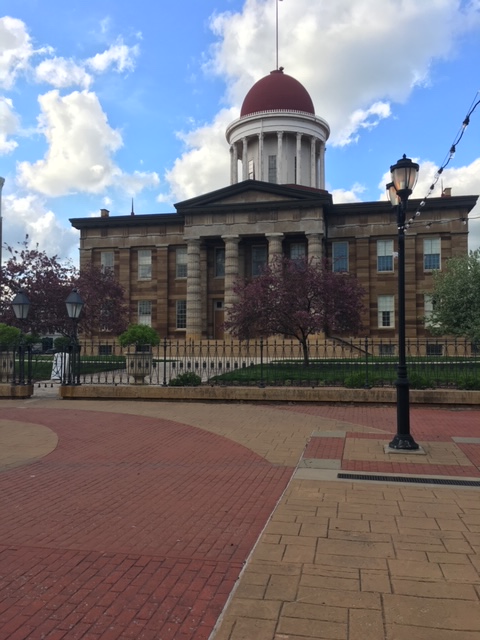
The Former Sangamon County Court House (1876-1966)
The terror and destruction of the Springfield Race Riot of 1908 did not physically end until about August 17th after the militia restored order to the city of Springfield. On September 6, 1908, Mabel Hallam signed an affidavit that George Richardson was not the person that believed raped and assaulted her and he was released from the Bloomington, Illinois jail. As the dust cleared seven men where dead: Scott Burton and William Donnegan both African American, and Louis Johnston, James Scott, John Colwell, Frank Delmore, and Louis Hanen all White. There were three rioters that where considered to be the ring leaders of the race riot: including the deaths of Scott Burton and William Donnegan. They were Kate Howard, Abraham Raymer and Earnest Humphrey. Kate Howard was charged with murder, inciting a riot, burglary and grand larceny of Harry Lopers restaurant. Howards reason for why she participated in the riots was that when was younger she had a similar incident as Mabel Hallam, that left an impression upon her and she sympathized with Hallam. However, instead of facing her crimes head on Howard decided after receiving the indictment for the murder of Scott Burton to take her own life by taking poison. Ernest “Slim” Humphrey was charged with the murder of Scott Burton and inciting a riot. However, he was later acquitted of all charges. Abraham Raymer was charged with the murder of William Donnegan, inciting a riot and grand larceny. He was acquitted of the murder of William Donnegan as well as inciting a riot, but found guilty of grand larceny for stealing Major Otis B. Duncan’s military sword. . The court made 107 indictments yet, no one was held accountable for the deaths of Scott Burton and William Donnigan. Justice for the lives and destruction of property did not prevail in the case of the Springfield Race Riot of 1908 and very few people were ever the same after the terror that swept through Springfield August 14 – 16, 1908.
Springfield, Illinois and America was changed drastically on August 14, 1908, the day Mabel Hallam decided to tell a lie. Mabel’s lie caused White citizens to murder, torture, intimidate, and terrorize African American citizens throughout Springfield. Yet, the lives of Scott Burton, and William Donnegan were not lost in vain because of Mabel Hallam’s lie. One of the most remarkable things to come from this horrific ordeal was the formation of National Association for the Advancement of Colored People, better known as the NAACP. The NAACP was started by a group of caring Americans of several races that wanted to see that all people had the opportunity to advance in America’s democracy. Many people lent their voices and talents to over coming the hate that continues to try to divide our America. Throughout America riots and lynchings are no longer silenced but used as a tool to provoke understanding and discourse that helps America to continue to become a more perfect union.
Mabel Vella Trees Hallam
Mabel Hallam- Vella “Mabel” Trees Hallam was married to William “Earl” Hallam on January 18, 1905. Earl was twenty years old and Mabel was just 18 years old. Mabel was born in Sherman Illinois to George and Susan Evans Trees. After marrying William “Earl” Hallam he and Mabel moved to Chicago for his new job as telephone inspector with Central Union Telephone Company. The following year in 1906 they had their first daughter Edna. Edna passed at the age of two on July 16, 1908, just about a month before the 1908 Race Riot occurred. The funeral was held at their home at 1145 N.5th St. When the riot happened, Earl was 23 years old and Mabel was 21 years old. At the time of the riot Earl was a streetcar conductor and Mabel was a stay at home wife. Mabel Hallam was never held accountable for filing a false criminal complaint against George Richardson. Earl and Mabel went on to have two more children (George Vaus Hallam born September 7, 1909 and William Evans Hallam born July 4, 1917). Mabel Hallam died on December 19, 1921 in Chicago Illinois at the age of 34.
George Richardson
George Richardson was the fourth son of Jordan & Sinette Florville Richardson. George was born on July 3, 1871. His mother Sinette was the daughter of wealthy Haitian businessman William “Billy the Barber” Florville. Billy the Barber was close personal friends with Abraham Lincoln. George’s family was well to do for the time and especially for an African American family. Although Richardson’s family had money he worked as a laborer. During the race riot a picture of George Richardson appeared in the newspaper that showed him to be a very dark skinned. However, George Richardson was a man said to be very fair skinned. According to Alice Taborn’s oral account given to the Council of Churches Race Relations Committee on September 29, 1947, “Mr. Richardson, the accused was of mixed blood, much lighter in complexion than Mrs. Earl Hallam.” George Richardson’s great grand-nephew Thomas Smith said to the author of this paper that, “we (his family) thought that the picture was altered or that the equipment that was used was inferior.” It is probable that the picture was altered to show Richardson as a dark and sinister character.
During the Springfield Race Riot of 1908, the newspapers described George Richardson as being a bad character and having an ugly record. For many years, the accusations were thought to be false and made to discredit George Richardson’s character. After investigating the accusations made by the Illinois State Register in 1908 the author of this paper has found many of the accusations to be true facts yet with some mistakes. The claims were as followed:
- Richardson cut up Bogue Kelly but was acquitted of the charges.
- Richardson murdered William Gowdy and served time in prison.
- Shot Brother James, who survived the near-death incident
These accusations are near to truth but not the whole truth:
- On July 1,1889 George Richardson at the age of 17 seriously injured a young man named Nicholas Kelly. The matter started when George was teasing a young girl at the house he and Kelly were working at. Kelly asked Richardson not to tease the girl and to give her back the items he took. At that moment, the incident went bad for Kelly. Richardson pulled a knife and cut Kelly in the back. Kelly’s name was also given as George as well as Bogue; however, Nicholas was mentioned more frequently. The confirmed proof to the case was that Richardson’s grandmother Phoebe Florville (wife of William “Billy the Barber” Florville) put up the 500.00 for his bond. In this case George Richardson was found guilty on December 20, 1889 and sentenced to one year in a Joliet prison.
- It was said during the Spfld. Race Riot that Richardson had shot and seriously injured his brother James Richardson over a disagreement of about 10cents. However, the matter was also said to be about the large inheritance their mother Sinette would leave her estate. The truth of the matter is James Richardson shot George Richardson on August 2, 1893 at their home that they shared with their mother Sinette. How the matter was resolved has not been discovered by the author of this paper.
- The other claim was the most serious. The newspapers claimed that George Richardson had murdered a man by the name of William Gowdy. The truth was that a George Richardson did murder another African American man by the name of John Gowdy over a 25-cent gambling bet on August 11, 1901. The accused George Richardson was found guilty of manslaughter and sentenced to five years in Chester Prison, after the jury had deliberated for over 24 hours. George Richardson was a common name and the articles do not give definitive information that states this is the same George Richardson accused in the 1908 Race Riot.
On August 21, 1908 George Richardson was asked about his character and this is what he said,
“I was born in Springfield and have spent all my life there. I have never done anything to be ashamed of there. Although I have at times got mixed up in a fight when I could not go get out of it. I have never been arrested before for a serious crime, and I have never committed one.”
Later in life Richardson worked and retired from the Bell Telephone company. George Richardson died at the age of 76, on February 9, 1948, still living at the home he lived in at 1305 E. Capital Ave in 1908.
Joe James
Joe James was accused of the July 5, 1908 murder of Clergy Ballard. The murder is said to have been during an alleged robbery and an attack on Ballard sixteen-year old daughter Blanche Ballard. James was found several blocks away from the Ballard home and blamed for the murder because he was new to Springfield and had no remembrance or alibi for the night of Ballard’s murder. James was born in 1891 and was originally from Birmingham, Alabama, the son of Catherine Roberts. James was beaten and placed in jail until his trial was to be held. James was waltzed out of town alone with Richardson in Harry Loper’s automobile. After the physical part of the race riot was over and things settled down James was returned to Springfield from Bloomington. James was represented by two African American Attorneys, Abraham Morris Williams and Octavius V. Royall. Williams and Royall tried helplessly to have James trial moved to another venue as they believed that there was even greater prejudice against James since the riots and James would not receive a fair trial in Springfield. James was found guilty and sentenced to hanging by the gallows for the murder of Clergy Ballard on Oct. 24, 1908. However, he should have received life in prison because he was 18 or under and not eligible for the death penalty. The hanging was scheduled for Oct.23, 1908, and Sheriff Charles Warner sent out 150 invitations for the hanging. On October 23, 1908 Joe James was hung with 147 people looking on. A funeral was held at Grace M. E. Church in Springfield, Illinois on October 26, 1908 and attended by his mother and a small group of African American citizens from the Springfield African American community. His body was shipped to Birmingham, Alabama and buried at the Knights of Pythias Cemetery.
Scott Burton
Scott Burton was murdered by a mob on August 15,1908 in Springfield, Illinois. Scott Burton was a businessman, a father and husband, and a well-known Race Man of the day. A Race Man is a man that is active in politics and in changing the circumstances of their race. In 1884 while living in Mt Pulaski where he had a barber shop, he visited the Clinton community and tried to encourage other Blacks to join the Democratic party. However, most Blacks were still loyal to the Republican party of Lincoln and refused to change. The African American community of Mt. Pulaski was rumored to have run Mr. Burton out of town with his new ideas. Burton’s son Charles Burton tells of how his father, was not trying to fight the rioters, but trying to protect his home. Scott Burton’s wife filed suit against the City of Springfield for sum of 5,000 for the loss of her husband’s life, and for property damage. Nearly four years after the riot on March 26, 1912 the City of Springfield settled with the Burton family for a total of 1,000.00 for personal property. $1,000.00 in 1912 is equivalent in purchasing power to about $26,844.12 in 2020.
William K. Donnegan
William K. Donnegan was born in about 1824. Mr. Donnegan was married to Sarah Donnegan, a Caucasian woman that he had been married to for over 30 years and had children with. By trade William Donnegan was a cobbler (known to be friends and cobbler for Abraham Lincoln) as well as a real estate investor; however, when America still enslaved African American’s Donnegan was a conductor of the Underground Railroad helping men and women to freedom. William Donnegan’s wife Sarah Donnegan brought a suit against the City of Springfield for the death of her husband. The original suit was for 5,000 dollars. However, nearly four years after the riot in May of 1912 the City of Springfield settled with the Donnegan family for a total of 1,500.00. In 1912, one thousand five hundred dollars is equivalent in purchasing power to about $40,266.19 in 2020.
Harry T. Loper
Harry T. Loper was a wealthy citizen of Springfield. Harry Townsend Loper was born in Greenfield, Illinois to John T. and Susan McBride Loper on September 24, 1860. Before going into the restaurant business Loper severed as a Major in the Illinois National Guard. His restaurant was described to be an exceptionally fine, elegant restaurant, much like the Maldeners restaurant that is still in business today. During the race riot in 1908 the mob destroyed his restaurant and his automobile that was used to take George Richardson and Joe James out of town to safety in Sherman, Ill to catch the train to Bloomington. Harry Loper owned the first car dealership in Springfield, Illinois. As proof of the speed of the car Harry Loper’s son Harry Loper Jr. was ticketed on October 4, 1907 for speeding in the business district at 6th and Washington. The speed in the business district was 6 miles an hour and Harry Jr were going twenty miles an hour and he was fined 100.00 for rapid driving. Harry Loper made a settlement with the City of Springfield for over 10,000 dollars. Harry T. Loper died March 1, 1948.
Kate Howard
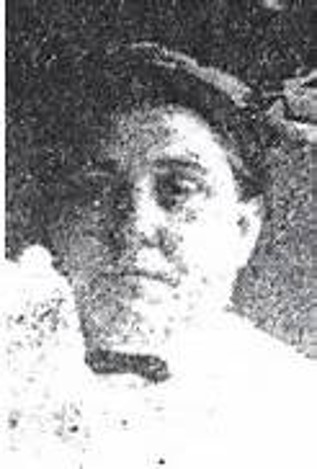
Kate Howard – Ring Leader Rioter- Committed Suicide
Ernest Humphrey and Abraham Raymer
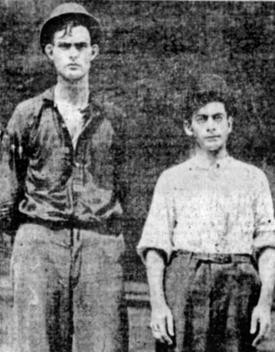
Ernest Humphrey and Abraham Raymer Ring Leaders of Riot, Humphrey was acquitted of all charges, Raymer acquitted of all charges except grand larceny.

